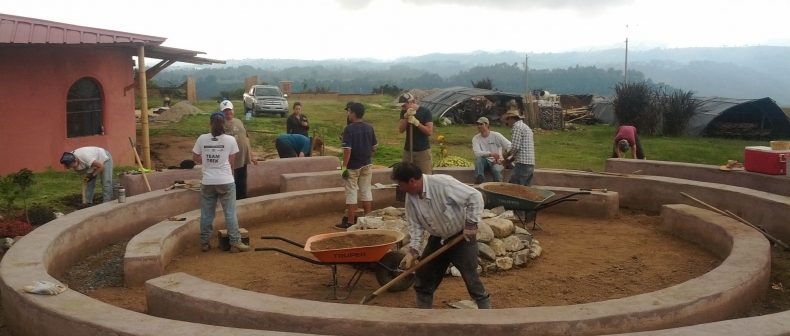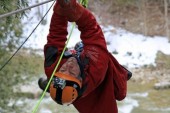
Bert Archer investigates the complicated world of ‘voluntourism.’ READ PART I
We landed in Guatemala City and were whisked right out to the more traditionally picturesque Antigua by Chris Buckshaw, the man behind El Camino VolunTours, the tour company GoVoluntouring uses for this project in Guatemala. It’s a shame: Flying in, the multi-level city looked fascinating, with houses built on every possible surface, including some, right up to the edges of promontories, that seemed on the verge of impossible.
But the whisking was a reminder of the “touring” part of voluntouring. Though the hook is the work, more usual tourism is a big part of the trip. And Antigua is lovely. But after a day and a night being charmed by its cobbled streets and marvelling at Renaissance-era paintings in Renaissance-era dining rooms (and stopping into a wine and cigar bar that, though quite good, seemed deeply un-Guatemalan), we hopped back in the van to drive the hour or so to Tecpán, the closest town to the little children’s village in the mountains Project Somos was having us in to help build.
I should mention at this point that the “we” I’m referring to is a group of journalists Flight Centre and Govoluntourism put together after the little talk Aaron and I had at the Royal York about taking a visit to Somos. Being a big multinational with some insight into economies of scale, I guess they figured one trip with one journalist may be good, but one trip with half a dozen would be better.
The next morning, we went to the site, at the top of a road that winds itself up into the highlands near Lake Atitlan, one of the countries’ big coffee-growing regions. There was a group from Vancouver already working, tamping down soil to ready it for paving stones and stuffing plastic pop bottles with plastic bags, all of it collected from the previously unkempt streets of Tecpán by kids Somos paid to do it. Once stuffed, the bottles became “eco bricks,” an Oprah-approved building material that I found fascinating and that also convinced me Somos was doing it right.
I had already looked into the orphan situation. As recent reports have highlighted, building orphanages in foreign lands can be a fraught thing indeed. It seems like one of the best possible good works, but what if, as happened in Haiti, all the money you pour into these places makes them so much better than anyone’s home that parents start abandoning their children to give them a better life at the orphanage? Absolute horror-show.
But as it happens, Guatemala does, indeed, have an unaddressed orphan problem. On January 1, 2008, the Guatemalan government halted all foreign adoptions to combat some pretty horrifying corruption of the system that included baby-theft. Prior to this, Guatemala had been one of the biggest sources of foreign adoptions in Canada and the US, due to a combination of its lack of access to abortion and a local machismo that often sees women abandoning children from previous relationships in the face of new boyfriends’ antipathy towards other men’s babies.
Somos was also going to be hiring local caregivers for the children’s village, as they are calling it, once it’s completed, in addition to making it self-sufficient, economically and otherwise, having staff and teaching the children to use its extensive arable land.
But it was those bricks that brought it all together. Guatemala’s infrastructure is bad. You can’t flush toilet paper down any of its tiny, clog-prone toilets, so every bathroom has a rather distasteful little wastepaper basket beside each commode. And they don’t pick up much garbage either, I’m told. So Somos honchos Greg Kemp and Heather Knox (both from Vancouver) pay poor children to pick up garbage, which is then turned into houses for even poorer children, with the extra benefit of being tremblor-friendly, the bottles being loosely enough held together to ripple rather than collapse when the earth moves. That is one enviable chain of virtuous causes and effects.
Local kids were paid to collect garbage that was recylced into building materials for Project Somos. Photo by Bert ArcherOne of the other major arguments against voluntourism is that the unskilled work tourists do often takes jobs away from locals. Once again, Somos emerges more or less unscathed, having a permanent, full-time crew of builders who work whether the tourists are there or not, doing all the building during low season, and being builder-trainers when we amateurs drop in for a week or 10 days to do our good works. (According to Knox and Kemp, they couldn’t afford any more workers than they employ full-time now, so make of that what you will.) According to Kemp, one of the benefits of having people flying in from all over to stack plastic bottles in chicken-wire wall frames is that it gives the permanent crew a sense of greater purpose and importance. If people are jetting in from thousands of kilometres away to do the work they do everyday they must be doing good work. He says worker morale gets a bump whenever the tourists arrive (this may be helped by the regular worker-tourist soccer games, which the workers almost inevitably win). There’s also a $250 charge added on to every voluntourist’s bill that goes directly to fund the regular workers’ wages.
I had an abbreviated look at the project: I worked 9-to-3 for three days. It wasn’t exhausting, but it was tiring, and it was inarguably work. Walls that weren’t built when I arrived were when I left. Many more have been built since. Knox and Kemp expect to have things finished next year. I won’t be able to take much credit when I get the pictures of the first kids moving in sent to my inbox — I figure I contributed to about a wall and a half — but I won’t be ashamed of it either, or even ambivalent. There are thousands of voluntourism packages out there. Some of them are outright scams, many more create situations in which you will do as much harm as good. There seem to be few that are unadulteratedly (or almost unadulteratedly) positive contributions. Somos is one. Use the checklist below to determine what the others may be.
***
Does the work need to be done?
Haiti is the object lesson here. Just because a country is poor does not mean it has an excess of orphans. We have read Dickens. We like the idea of orphans. But does the situation in the country you’re considering voluntouring through actually produce an excess of children without immediate or extended families to care for them? If not, don’t go and build an orphanage there. Ditto any form of construction when there’s sufficient local infrastructure to do its own constructing, or conservation when the ecosystem is sufficiently funded. How do you tell if it’s sufficiently funded? Well, that takes some work.
Does the work need to be done by you?
If you’re considering going to an African village to dig a well, take a look and a think into whether you, an otherwise unskilled digger, need to do it. Were all the men killed in some civil or international dispute and the women all up to their necks in childcare? Are the adults all sickly and unable to work? Does part of the cost of your voluntrip going to pay local workers? If not, make some inquiries.
Are you actually able to do what you’re signing on to do?
There is a form of voluntourism, best embodied by the without-borders genre of NGO (Doctors Without Borders, Engineers Without Borders, etc.), that takes advantage of specific and valuable skills. But if you’re planning on doing work you’ve never done before (or only informally), ask yourself if you should be doing it at all.
How big is your footprint?
Where does the voluntourism outfit propose to put you up? It’s come to light in recent years that foreign aid workers have a tendency to use up enormous amounts of local resources (water, electricity, etc.), creating a wake that rivals whatever good works they leave behind. Are you living like a local or like a tourist? If it’s the latter, you may want to think again.
____
Bert Archer writes for Toronto Standard. Follow him on Twitter: @bertarcher.
For more, follow us on Twitter: @TorontoStandard, or subscribe to our newsletter.














